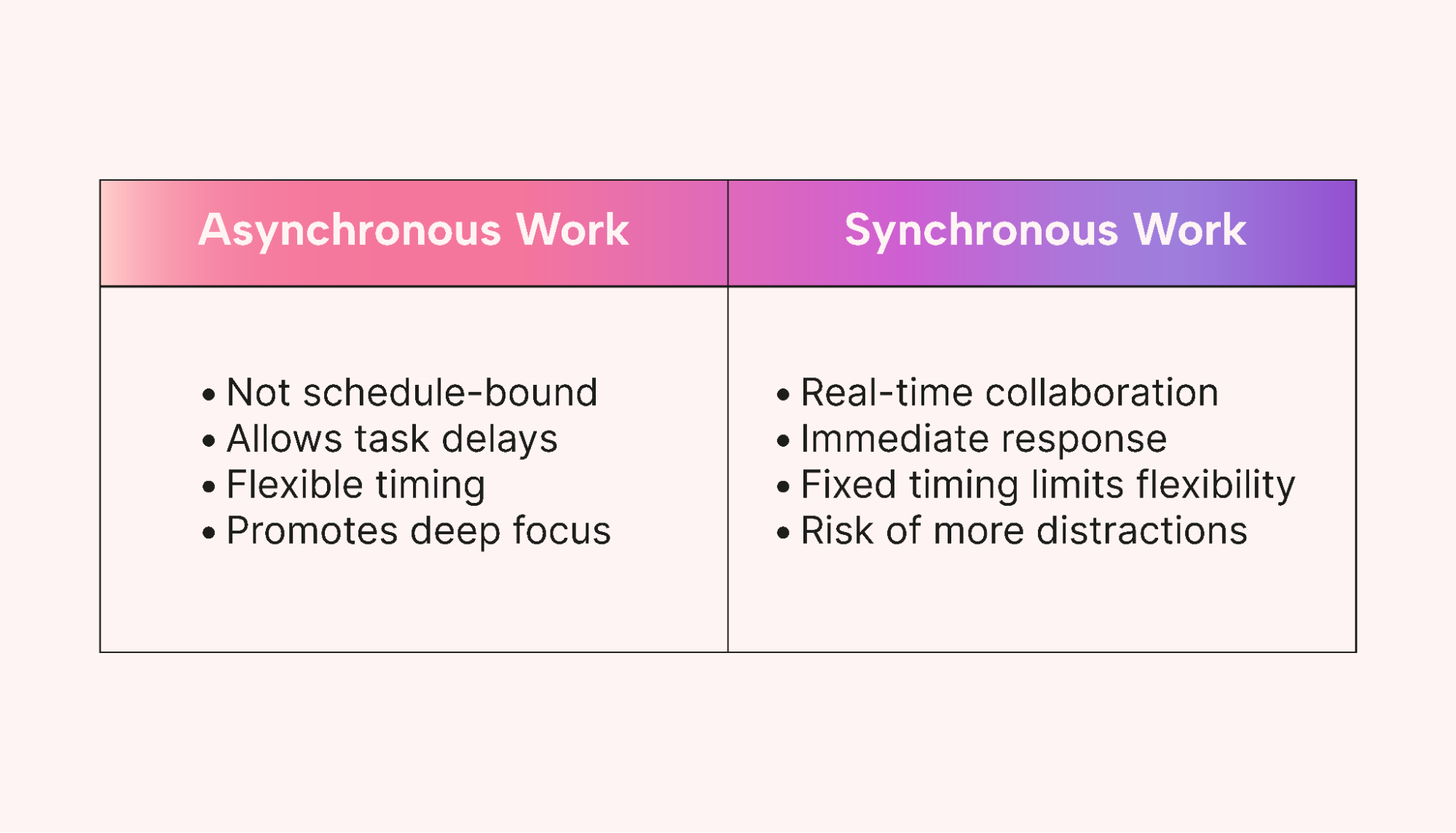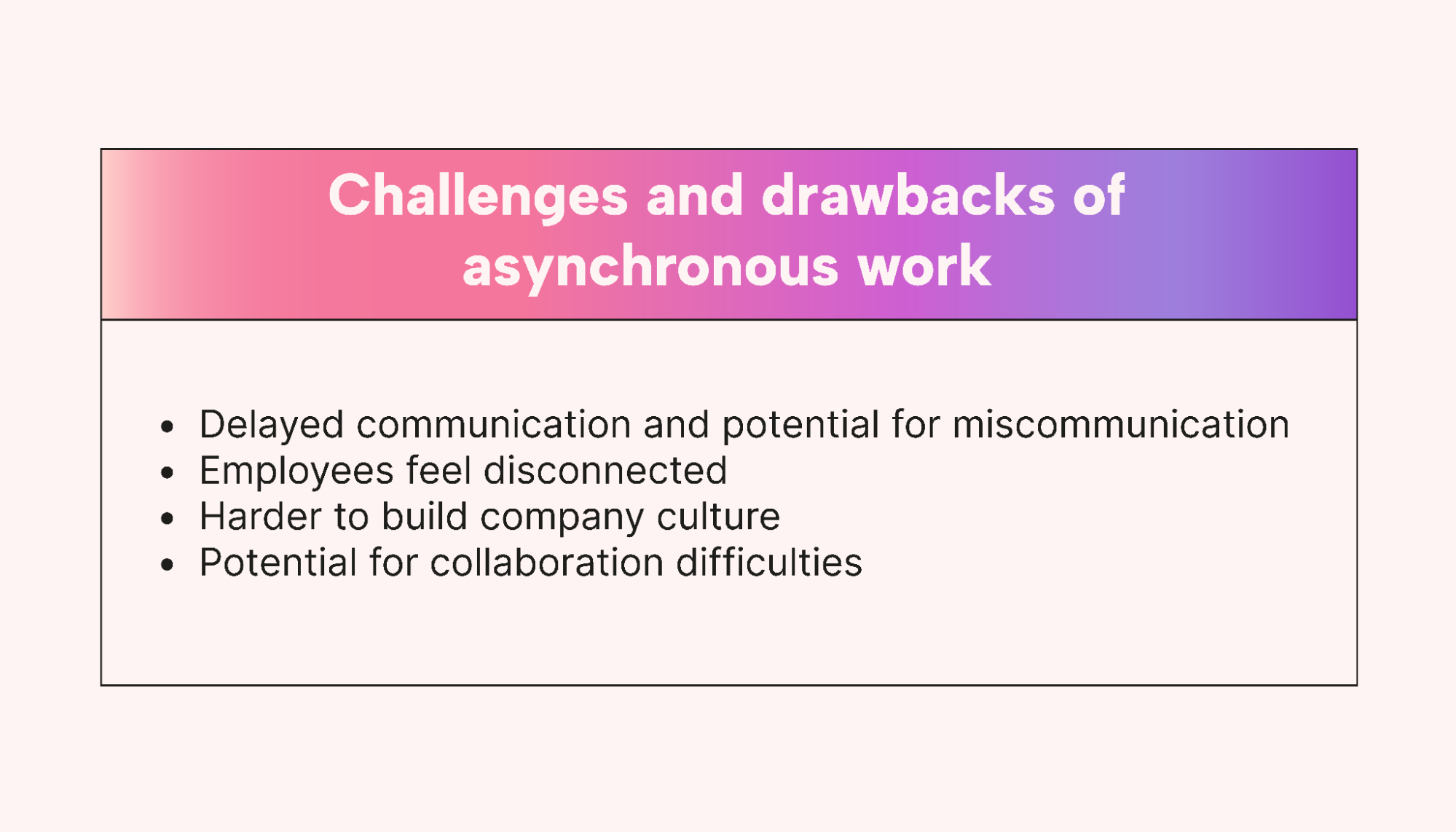In today’s fast-paced work environment, finding the balance between communication, collaboration, and focused productivity is often elusive.
Research shows that 35% of people believe asynchronous work, or working without always being “online” at the same time, could lead to more purposeful and less distracting communication. Even more telling, 42% of workers feel this way of working is the future.
However, there’s a catch: a whopping 58% of employees feel their companies aren’t equipped for this change. This makes one thing clear: asynchronous work can be great, but only if you have the right tools and know-how.
In this article, we explain what it means to work asynchronously, plus the tools and approach you need to get it right.
What is asynchronous work?
Asynchronous or async work is a way of working that doesn’t require all participants or team members to be available at the same time. Instead, tasks, communications, and collaboration happen independently of time — allowing employees to work according to their own schedules and preferences.
Asynchronous work is particularly prevalent in remote work environments, though many traditional offices are also adopting asynchronous practices to increase flexibility and productivity. However, it’s worth noting that a balance between synchronous (real-time) and asynchronous activities can be ideal for maintaining team cohesion and timely communication.
Key features and aspects of asynchronous work include the following:
- Flexible schedules: Employees can work when they are most productive or when it’s convenient for them rather than adhering to a strict 9-to-5 schedule.
- Task-oriented: Focus is on completing tasks or projects rather than being present during specific hours.
- Technology-driven: Asynchronous work often relies on team collaboration software and project management tools that allow for time-independent communication and collaboration.
- Global collaboration: Teams spread across different time zones can collaborate without everyone needing to adjust their schedules for real-time meetings.
How is asynchronous work different from synchronous work?
Synchronous work involves real-time interactions. In asynchronous work, however, the team members aren’t necessarily working at the same time.
Here’s a breakdown of the main differences between these two modes of work:
 |
Timing
Asynchronous: Tasks and communication don’t happen in real time. Team members don’t need to be present or available at the same time to collaborate or communicate.
Synchronous: Tasks and communication occur in real time, requiring all participants to be available simultaneously.
Communication
Asynchronous: Communication tools often include email, task management software, and messaging platforms where the sender doesn’t expect an instant reply. Messages can be read and responded to at the recipient’s convenience.
Synchronous: Communication typically occurs through real-time methods, like face-to-face meetings, video conferences, and phone calls.
Flexibility
Asynchronous: Team members can work at times that suit their schedules and peak productivity periods.
Synchronous: Team members coordinate their availability for real-time interactions.
Location
Asynchronous: Asynchronous work is especially beneficial for distributed or remote teams spread across different time zones.
Synchronous: Synchronous work is common in traditional office settings, though it can also be present in remote settings through scheduled meetings.
Task focus
Asynchronous: The focus is more on task completion than specific working hours. Deadlines are essential, but exactly when the work will occur is more fluid.
Synchronous: The focus is on both task completion and specific working hours, especially if coordinated efforts or meetings are necessary.
Collaboration
Asynchronous: Collaboration happens over extended periods, allowing time for deep thinking and individual contributions. Feedback cycles might be longer.
Synchronous: Real-time collaboration can lead to instant feedback and quicker decision-making. It’s ideal for brainstorming sessions or discussions that require an immediate consensus.
Interruptions and deep work
Asynchronous: Frequent interruptions are reduced, which allows for longer periods of concentrated, deep work.
Synchronous: Real-time interactions can sometimes lead to more fragmented workdays, with potential interruptions from meetings and instant messages.
Culture and team building
Asynchronous: Building a company culture and team camaraderie might require more intentional efforts since there are fewer spontaneous interactions.
Synchronous: It’s easier to foster team relationships through real-time interactions, water cooler chats, and shared experiences.
Benefits of asynchronous work
Diving into the world of asynchronous work uncovers a goldmine of advantages for both organizations and individuals. Here are just a few of them:
Promotes creativity
According to research published in the Harvard Business Review, one of the standout advantages of asynchronous work is its potential to fuel creativity. Giving employees the flexibility to work during their peak creative times without the constant interruption of real-time demands helps pave the way for deeper reflection and innovative thinking.
Improves flexibility
Gone is the rigid 9-to-5 schedule. Asynchronous work brings unparalleled flexibility, letting employees adjust their work hours based on their personal schedules, peak productivity times, or even time zones.
Harnesses peak productivity times
Asynchronous work acknowledges the fact that productivity is not a one-size-fits-all matter. Businesses with traditional work hours often operate under the assumption that early mornings are the prime time for maximum efficiency. However, recent research contradicts this, suggesting that not everyone is at their most productive in the morning.
Companies that embrace asynchronous work help their employees harness their personal peak productivity times, whether they’re early birds or night owls.
Promotes work-life balance
Asynchronous work inherently supports work-life balance. Employees can weave their work around their life commitments — whether these are school runs, appointments, or personal hobbies — rather than the other way around.
Ensures access to global talent
No longer confined by geographical boundaries, organizations can tap into a vast pool of global talent. Asynchronous work means that the best person for each job can be anywhere in the world, bringing diverse perspectives and skills to the table.
 |
Ensures employee autonomy
Asynchronous work gives employees more control over their schedules, allowing them to choose the hours they do their best work. This independence not only boosts morale but also creates a sense of ownership over — and responsibility toward — tasks.
Promotes documentation
A significant advantage of asynchronous communication is its emphasis on thorough documentation. Less real-time interaction means a natural inclination to document processes, decisions, and feedback, ensuring that everything is traceable and accessible to all team members.
Allows for scalability
Traditional, synchronous models often strain under rapid growth, leading to communication breakdowns and inefficiencies.
But asynchronous methods, which are built on robust documentation and flexible tools, can swiftly adapt to increased workloads and team sizes without missing a beat. This scalability ensures that businesses are always poised for growth and evolution, ready to embrace new opportunities as they arise.
Reduces burnout
Without the constant ping of real-time messages or impromptu meetings, employees can delve into periods of deep, undisturbed work. This environment often results in higher-quality outputs and innovative solutions, as employees can fully immerse themselves in their tasks without distractions.
Challenges and drawbacks of asynchronous work
While asynchronous work offers numerous benefits, it also comes with the following challenges and drawbacks:
 |
Delayed communication
While asynchronous work offers the luxury of responding in one’s own time, it also means that urgent questions might not get immediate answers. Depending on team members’ schedules or time zones, significant lags in receiving feedback can arise — leading to frustrations and potentially stalling project timelines.
Potential for miscommunication
Without real-time clarifications or cues like tone and body language, written messages in asynchronous communication can be misinterpreted. This can lead to errors, misaligned expectations, or even conflict. As such, clear and concise writing skills are essential.
Isolation
Fewer live interactions mean employees may begin to feel disconnected from their colleagues and the company community as a whole. If not addressed, this can lead to feelings of loneliness, a lack of team cohesion, or even burnout.
Decision making
While asynchronous communication fosters individual productivity, it can sometimes hamper collective decision-making. Deliberations that might have taken minutes in a live meeting could span multiple days, especially if the team members are spread across time zones or have different work schedules.
Best practices for implementing asynchronous work
Successfully implementing asynchronous work requires intentionality, the right tools, and an understanding of the unique challenges such work presents.
Here are 11 best practices for integrating asynchronous work:
1. Set clear expectations
Clearly define the roles, responsibilities, and expectations for both the managers and team members. Everyone should understand what’s expected of them in terms of output and response times.
2. Use the right tools
Invest in collaboration and communication tools suited for asynchronous work.
Motion stands out as a comprehensive solution that streamlines workflows and keeps all teams, asynchronous or not, on the same page. Motion offers an integrated approach, ensuring seamless communication and task management for modern teams.
3. Document everything
Maintain thorough documentation of projects, decisions, meetings, and other essential communications. This will ensure everyone can access the information they need, even if they weren’t involved in the initial conversation.
4. Schedule check-ins
Schedule regular check-ins or team meetings to maintain team cohesion, clarify doubts, and provide a space for synchronous communication.
5. Provide training and onboarding
Ensure team members are trained in the tools and methodologies specific to asynchronous work. A structured onboarding process is crucial to ensure everyone starts on the right foot.
6. Prioritize communication
Encourage open, transparent communication. Provide guidelines on effective written communication to avoid misunderstandings and ensure clarity.
 |
7. Respect boundaries
It’s crucial to respect personal boundaries, including in an asynchronous setup. Don’t expect an immediate response from someone outside of their working hours.
8. Create feedback loops
Establish regular feedback mechanisms to understand what’s working and what’s not. This helps in adapting and refining asynchronous processes as needed.
9. Encourage breaks and downtime
The lines between work and personal time can blur. So, remind team members to take regular breaks and prioritize work-life balance.
10. Incorporate cultural initiatives
Foster a sense of community and culture through virtual team-building activities, chat rooms for non-work conversations, or other initiatives to help build rapport among remote, asynchronous teams.
11. Celebrate successes
Recognition is crucial, even in an asynchronous environment. Celebrate team achievements and individual successes to foster motivation and a sense of belonging.
5 examples of asynchronous work
To show you how asynchronous work looks in practice, here are five real-world ways people are working asynchronously.
1. Email
One of the most classic forms of asynchronous communication is email. Unlike instant messaging, where immediate responses are often expected, email allows recipients to read, digest, and respond to messages at their convenience. This enables focused work blocks without constant interruptions. Email’s global accessibility also means teams spread across various time zones can effectively communicate without needing to be online simultaneously.
2. Task management systems
Tools like Motion provide a centralized platform where tasks can be assigned, tracked, and updated without real-time interaction. Team members can update their progress, set deadlines, and prioritize tasks at times that work best for them. Such systems minimize the need for constant check-ins, providing clarity on team objectives and individual responsibilities.
3. Document collaboration
Gone are the days when document collaboration required team members to be present in the same room or on the same call. Platforms like Google Docs allow multiple users to edit, comment on, and review a single document in their own time. The changes are saved and synced, ensuring everyone has access to the latest version of the document. This promotes collaboration but without the constraints of synchronized schedules.
4. Video messages
Video messages powered by platforms like Loom provide a personal touch to asynchronous communication without the need to schedule video calls. This approach retains the benefits of face-to-face communication, such as visual cues and personal connection, while allowing viewers to watch and respond when it’s most convenient for them.
5. Knowledge bases and wikis
Knowledge bases and wikis serve as central repositories of information that can be accessed and updated asynchronously. Team members can contribute to, modify, or fetch data from these bases without the need for real-time collaboration. This ensures that institutional knowledge can be preserved, easily accessible, and built upon over time.
Harness the power of asynchronous work with Motion
Maximizing the rewards of asynchronous work hinges on two core principles: adopting the right methodologies and using the right tools.
The landscape of remote work is filled with promises of flexibility and efficiency, but to truly unlock these benefits, tools like Motion are indispensable. Motion transforms the way teams approach asynchronous tasks, making collaboration smooth and intuitive.
Ready to revolutionize your team’s workflow? Dive into the future of efficient work by signing up for Motion’s 7-day free trial today.





